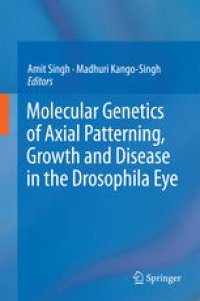
Ebook: Molecular Genetics of Axial Patterning, Growth and Disease in the Drosophila Eye
- Tags: Human Genetics, Animal Models, Biomedicine general
- Year: 2013
- Publisher: Springer-Verlag New York
- Edition: 1
- Language: English
- pdf
Undoubtedly, Drosophila melanogaster, fruit fly, has proved to be one of the most popular invertebrate model organisms, and the work horse for modern day biologists. Drosophila, a highly versatile model with a genetic legacy of more than a century, provides powerful genetic, cellular, biochemical and molecular biology tools to address many questions extending from basic biology to human diseases. One of the most important questions in biology focuses on how does a multi-cellular organism develop from a single-celled embryo. The discovery of the genes responsible for pattern formation has helped refine this question, and led to other questions, such as the role of various genetics and cell biological pathways in regulating the crucial process of pattern formation and growth during organogenesis. Drosophila eye model has been extensively used to study molecular genetic mechanisms involved in patterning and growth. Since the genetic machinery involved in the Drosophila eye is similar to humans, it has been used to model human diseases and homology to eyes in other taxa. This book will discuss molecular genetic mechanisms of pattern formation, mutations in axial patterning, Genetic regulation of growth in Drosophila eye, and more. There have been no titles in the past ten years covering this topic, thus an update is urgently needed.
Undoubtedly, Drosophila melanogaster, fruit fly, has proven to be one of the most popular invertebrate model organisms, and the work horse for modern day biologists. Drosophila, a highly versatile model with a genetic legacy of more than a century, provides powerful genetic, cellular, biochemical and molecular biology tools to address many questions extending from basic biology to human diseases. One of the most important questions in biology focuses on: how does a multi-cellular organism develop from a single-celled embryo? The discovery of the genes responsible for pattern formation has helped refine this question. Drosophila eye model has been extensively used to study molecular genetic mechanisms involved in patterning and growth. Since the genetic machinery involved in the Drosophila eye is similar to humans, it has been used to model human diseases and homology to eyes in other taxa. This book will discuss molecular genetic mechanisms of pattern formation, axial patterning, growth regulation in Drosophila eye, and more.
Undoubtedly, Drosophila melanogaster, fruit fly, has proven to be one of the most popular invertebrate model organisms, and the work horse for modern day biologists. Drosophila, a highly versatile model with a genetic legacy of more than a century, provides powerful genetic, cellular, biochemical and molecular biology tools to address many questions extending from basic biology to human diseases. One of the most important questions in biology focuses on: how does a multi-cellular organism develop from a single-celled embryo? The discovery of the genes responsible for pattern formation has helped refine this question. Drosophila eye model has been extensively used to study molecular genetic mechanisms involved in patterning and growth. Since the genetic machinery involved in the Drosophila eye is similar to humans, it has been used to model human diseases and homology to eyes in other taxa. This book will discuss molecular genetic mechanisms of pattern formation, axial patterning, growth regulation in Drosophila eye, and more.
Content:
Front Matter....Pages i-xiv
Early Eye Development: Specification and Determination....Pages 1-36
Molecular Genetic Mechanisms of Axial Patterning: Mechanistic Insights into Generation of Axes in the Developing Eye....Pages 37-73
Catching the Next Wave: Patterning of the Drosophila Eye by the Morphogenetic Furrow....Pages 75-97
Cell Morphogenesis: Tracing the Paths of Induction During Drosophila Ommatidial Development....Pages 99-140
Cell Polarity in Drosophila Retina....Pages 141-162
Negative Regulation for Neural Patterning in the Drosophila eye....Pages 163-181
Cell Adhesion During Drosophila Eye Development....Pages 183-202
Modulation of Developmental Signaling by the Proteostasis Network....Pages 203-228
Drosophila Eye as a Model to Study Regulation of Growth Control: The Discovery of Size Control Pathways....Pages 229-270
Unraveling the Basis of Neurodegeneration using the Drosophila Eye....Pages 271-293
Genetic Regulation of Early Eye Development in Non-dipteran Insects....Pages 295-328
Development and Evolution of the Drosophila Bolwig’s Organ: A Compound Eye Relict....Pages 329-357
Back Matter....Pages 359-368